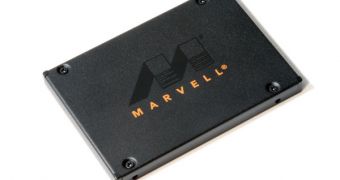The SATA 6Gbps has been getting more and more attention, but not many storage units have been built capable of utilizing its high-speed data-transfer capabilities. Still, it seems that end-users may finally manage to get an idea of just what the interface is capable of. The people over at PC Perspective managed to get their hands on a Marvell prototype version of an SATA 6Gbps Solid State Drive.
The unit was made using ROM memory instead of FLASH, because of cost issues, so it excluded any sort of write-speed tests. Nevertheless, the read-speed benchmarks are nothing short of amazing, even for speed enthusiasts, with the performance exceeding even those of the quicker SSDs on the market, such as Intel's X25-M G2.
Certainly, Seagate was the first to introduce an SATA 6Gbps drive, but its product was a hard drive, not an SSD. Of course, the benchmarked product from Marvell isn't exactly a real product, but it may still hold some clues as to just how much of a performance increase the SATA 6Gbps interface can yield.
Tests were done in comparison with Intel's X25-M G2 SSD and the total read-speed percentage by which Marvell's prototype exceeded Intel's drive was of 33%, in burst performance tests, and of 27% in sustained read-speed tests. In addition, the sustained read speed of Marvell's unit was no less than 175% higher than that of Seagate's hard drive.
The actual hardware configuration on which the early prototype was tested was made up of the ASUS P7P55D-E Premium motherboard running an Intel Core i7-860 CPU. The setup used a 4GB Corsair DDR3-1333 memory and ran Windows 7 Professional x64.
Marvell's product is, unfortunately, only an engineering sample for testing purposes. The manufacturer will not be making SSDs, only controllers, which means that the benchmarked storage unit will never become a “real” product. Still, even though there is, currently, no real way of knowing if the groundbreaking speed of the new interface is as high as suggested, these tests seem to indicate that end-users buying SATA 6Gbps-capable motherboards will likely not regret their purchase.

 14 DAY TRIAL //
14 DAY TRIAL //